Spatiotemporal Evolution of County-Level Land Use Structure in the Context of Urban Shrinkage: Evidence from Northeast China
Abstract
1. Introduction
2. Data and Methods
2.1. Study Area
2.2. Data
2.3. Methods
2.3.1. Resident Population Change Rate
2.3.2. Land Use Transfer Matrix
2.3.3. Common Edge Measure Method
3. Results
3.1. The Changing Characteristics of Resident Population in Northeast China
3.2. Changes in Land Use Structure in Shrinking Units
3.3. Expansion of Construction Land in Shrinking Units
4. Discussion
4.1. Causes of the Increasingly Severe Resident Population Loss in Northeast China
4.2. Paradox of Population Loss and Construction Land Expansion
4.3. Adjusting the Expansion Model for New Construction Land in Shrinking Cities
5. Conclusions
Author Contributions
Funding
Data Availability Statement
Acknowledgments
Conflicts of Interest
References
- Zhang, L.; Zhang, L.; Xu, Y.; Zhou, P.; Yeh, C.-H. Evaluating urban land use efficiency with interacting criteria: An empirical study of cities in Jiangsu China. Land Use Policy 2020, 90, 104292. [Google Scholar] [CrossRef]
- Wang, J.; Qu, S.; Peng, K.; Feng, Y. Quantifying urban sprawl and its driving forces in china. Discret. Dyn. Nat. Soc. 2019, 2019, 2606950. [Google Scholar] [CrossRef]
- Sun, Y.; Li, Y.; Gao, J.; Yan, Y. Spatial and temporal patterns of urban land use structure in small towns in China. Land 2022, 11, 1262. [Google Scholar] [CrossRef]
- Fu, Y.H.; Zhou, T.T.; Yao, Y.Y.; Qiu, A.G.; Wei, F.Q.; Liu, J.Q.; Liu, T. Evaluating efficiency and order of urban land use structure: An empirical study of cities in Jiangsu, China. J. Clean. Prod. 2021, 283, 124638. [Google Scholar] [CrossRef]
- Tu, F.; Yu, X.; Ruan, J. Industrial land use efficiency under government intervention: Evidence from Hangzhou, China. Habitat Int. 2014, 43, 1–10. [Google Scholar] [CrossRef]
- Lu, X.-H.; Ke, S.-G. Evaluating the effectiveness of sustainable urban land use in China from the perspective of sustainable urbanization. Habitat Int. 2018, 77, 90–98. [Google Scholar] [CrossRef]
- FFu, C.; Song, X.-P.; Stewart, K. Integrating activity-based geographic information and long-term remote sensing to characterize urban land use change. Remote Sens. 2019, 11, 2965. [Google Scholar] [CrossRef]
- Sun, Q.; Zhang, C.; Liu, M.; Zhang, Y. Land use and land cover change based on historical space-time model. Solid Earth 2016, 7, 1395–1403. [Google Scholar] [CrossRef]
- Zhou, Y.; Li, X.; Liu, Y. Land use change and driving factors in rural China during the period 1995–2015. Land Use Policy 2020, 99, 105048. [Google Scholar] [CrossRef]
- Bao, G.Y.; Huang, H.; Gao, Y.N.; Wang, D.B. Study on driving mechanisms of land use change in the coastal area of Jiangsu, China. J. Coast. Res. 2017, 79, 104–108. [Google Scholar] [CrossRef]
- Chen, W.; Zeng, J.; Li, N. Change in land-use structure due to urbanisation in China. J. Clean. Prod. 2021, 321, 128986. [Google Scholar] [CrossRef]
- Chen, Z.; Zhou, Y.; Haynes, K.E. Change in land use structure in urban China: Does the development of high-speed rail make a difference. Land Use Policy 2021, 111, 104962. [Google Scholar] [CrossRef]
- Tian, L.; Li, Y.; Shao, L.; Zhang, Y. Measuring spatio-temporal characteristics of city expansion and its driving forces in Shanghai from 1990 to 2015. Chin. Geogr. Sci. 2017, 27, 875–890. [Google Scholar] [CrossRef]
- Zavadil, T.; Jancak, V. Farmers shaping the landscape: How do they influence the form of landscape and land use structure in Czechia? Geografie 2021, 126, 319–345. [Google Scholar] [CrossRef]
- Chuangchang, P.; Thinnukool, O.; Tongkumchum, P. Modelling urban growth over time using grid-digitized method with variance inflation factors applied to spatial correlation. Arab. J. Geosci. 2016, 9, 342. [Google Scholar] [CrossRef]
- Liu, F.; Zheng, X.; Huang, Q. Predictive measurement of the structure of land use in an urban agglomeration space. Sustainability 2018, 10, 65. [Google Scholar] [CrossRef]
- Wang, Q.; Wang, H. An integrated approach of logistic-MCE-CA-markov to predict the land use structure and their micro-spatial characteristics analysis in Wuhan metropolitan area, central China. Environ. Sci. Pollut. Res. 2022, 29, 30030–30053. [Google Scholar] [CrossRef]
- Zhou, X.; Fu, W. A multi-agent simulation method of urban land layout structure based on FPGA. Mob. Netw. Appl. 2020, 25, 1572–1581. [Google Scholar] [CrossRef]
- Ma, S.; Wen, Z. Optimization of land use structure to balance economic benefits and ecosystem services under uncertainties: A case study in Wuhan, China. J. Clean. Prod. 2021, 311, 127537. [Google Scholar] [CrossRef]
- Wang, S.-D.; Zhang, H.-B.; Wang, X.-C. Simulating land use structure optimization based on an improved multi-objective differential evolution algorithm. Pol. J. Environ. Stud. 2019, 28, 887–899. [Google Scholar] [CrossRef]
- Xue, M.; Ma, S. Optimized land-use scheme based on ecosystem service value: Case study of Taiyuan, China. J. Urban Plan. Dev. 2018, 144, 04018016. [Google Scholar] [CrossRef]
- Yao, J.; Murray, A.T.; Wang, J.; Zhang, X. Evaluation and development of sustainable urban land use plans through spatial optimization. Trans. Gis 2019, 23, 705–725. [Google Scholar] [CrossRef]
- Zhao, X.; Tan, K.; Xie, P.; Chen, B.; Pu, J. Multiobjective land-use optimization allocation in eucalyptus-introduced regions based on the GMDP-ACO model. J. Urban Plan. Dev. 2021, 147, 05021004. [Google Scholar] [CrossRef]
- Sun, P.; Wang, K. Identification and stage division of urban shrinkage in the three provinces of Northeast China. Acta Geogr. Sin. 2021, 6, 1366–1379. (In Chinese) [Google Scholar] [CrossRef]
- Gao, S.; Long, Y. Distinguishing and planning shrinking cities in Northeast China. Planners 2017, 33, 26–32. (In Chinese) [Google Scholar]
- Long, Y.; Wu, K.; Wang, J. Shrinking cities in China. Mod. Urban Res. 2015, 14–19. (In Chinese) [Google Scholar] [CrossRef]
- Wu, K.; Long, Y.; Yang, Y. Urban shrinkage in the Beijing-Tianjin-Hebei region and Yangtze river delta: Pattern, trajectory and factors. Mod. Urban Res. 2015, 26–35. (In Chinese) [Google Scholar] [CrossRef]
- Wu, K.; Qi, W. Shrinking cities: Misunderstandings, identifications and reflections. Geogr. Res. 2021, 40, 213–229. (In Chinese) [Google Scholar] [CrossRef]
- Du, Z.; Li, X. Growth or shrinkage: New phenomena of regional development in the rapidly-urbanising Pearl River delta. Acta Geogr. Sin. 2017, 72, 1800–1811. (In Chinese) [Google Scholar] [CrossRef]
- Du, Z.; Li, X. Characteristic and mechanism ofurban growth and shrinkage from demographic change perspective: A case study of dongguan. Sci. Geogr. Sin. 2018, 38, 1837–1846. (In Chinese) [Google Scholar] [CrossRef]
- Häußermann, H.; Siebel, W. Die schrumpfende Stadt und die Stadtsoziologie. In Soziologische Stadtforschung; Springer: Berlin, Germany, 1988; pp. 78–94. [Google Scholar]
- Mallach, A.; Haase, A.; Hattori, K. The shrinking city in comparative perspective: Contrasting dynamics and responses to urban shrinkage. Cities 2017, 69, 102–108. [Google Scholar] [CrossRef]
- Yang, D.; Long, Y.; Yang, W.; Sun, H. Losing population with expanding space: Paradox of urban shrinkage in China. Mod. Urban Res. 2015, 9, 20–25. (In Chinese) [Google Scholar] [CrossRef]
- Wiechmann, T.; Pallagst, K.M. Urban shrinkage in Germany and the USA: A comparison of transformation patterns and local strategies. Int. J. Urban Reg. Res. 2012, 36, 261–280. [Google Scholar] [CrossRef]
- Pacione, M. Environments of disadvantage: Geographies of persistent poverty in Glasgow. Scott. Geogr. J. 2004, 120, 117–132. [Google Scholar] [CrossRef]
- Meng, X.; Ma, S.; Xiang, W.; Wu, K.; Long, Y. Classification of shrinking cities in China using Baidu big data. Acta Geogr. Sin. 2021, 76, 2477–2488. (In Chinese) [Google Scholar] [CrossRef]
- Reis, J.P.; Silva, E.A.; Pinho, P. Spatial metrics to study urban patterns in growing and shrinking cities. Urban Geogr. 2016, 37, 246–271. [Google Scholar] [CrossRef]
- Hospers, G.-J. Policy responses to urban shrinkage: From growth thinking to civic engagement. Eur. Plan. Stud. 2014, 22, 1507–1523. [Google Scholar] [CrossRef]
- Gao, S. A review of researches on shrinking cities. Urban Plan. Forum 2015, 3, 44–49. (In Chinese) [Google Scholar] [CrossRef]
- Liu, J.; Kuang, W.; Zhang, Z.; Xu, X.; Qin, Y.; Ning, J.; Zhou, W.; Zhang, S.; Li, R.; Yan, C. Spatiotemporal characteristics, patterns, and causes of land-use changes in China since the late 1980s. J. Geogr. Sci. 2014, 24, 195–210. [Google Scholar] [CrossRef]
- Jiyuan, L. Study on spatial pattern of land-use change in China during 1995–2000. Sci. China Ser. D Earth Sci. 2002, 46, 373–384. [Google Scholar]
- Liu, Y.; Liu, Y.; Chen, Y.; Long, H. The process and driving forces of rural hollowing in China under rapid urbanization. J. Geogr. Sci. 2010, 20, 876–888. [Google Scholar] [CrossRef]
- Yang, Y.; Bao, W.; Li, Y.; Wang, Y.; Chen, Z. Land use transition and its eco-environmental effects in the Beijing–Tianjin–Hebei urban agglomeration: A production–Living–Ecological perspective. Land 2020, 9, 285. [Google Scholar] [CrossRef]
- Tian, J.; Wang, B.; Zhang, C.; Li, W.; Wang, S. Mechanism of regional land use transition in underdeveloped areas of China: A case study of northeast China. Land Use Policy 2020, 94, 104538. [Google Scholar] [CrossRef]
- Jing, Z.; Wang, J.; Tang, Q.; Liu, B.; Niu, H. Evolution of land use in coal-based cities based on the ecological niche theory: A case study in Shuozhou city, China. Resour. Policy 2021, 74, 102245. [Google Scholar] [CrossRef]
- Dong, G.; Ge, Y.; Jia, H.; Sun, C.; Pan, S. Land use multi-suitability, land resource scarcity and diversity of human needs: A new framework for land use conflict identification. Land 2021, 10, 1003. [Google Scholar] [CrossRef]
- Den, X.; Gibson, J. Sustainable land use management for improving land eco-efficiency: A case study of Hebei, China. Ann. Oper. Res. 2020, 290, 265–277. [Google Scholar] [CrossRef]
- Song, Y.; Zhu, D.L.; Yeung, G.; Xu, Y.; Zhang, L.X. Spatio-temporal evolution and driving mechanism of urban land use structure with the context of urban shrinkage: Evidence from Northeast China. Geogr. Res. 2021, 40, 1387–1403. (In Chinese) [Google Scholar] [CrossRef]
- Beyer, E.; Hagemann, A.; Rieniets, T.; Oswalt, P. Atlas of Shrinking Cities; Hatje Cantz: Berlin, Germany, 2006. [Google Scholar]
- Chen, J.; Gao, J.; Yuan, F. Growth type and functional trajectories: An empirical study of urban expansion in Nanjing, China. PLoS ONE 2016, 11, e0148389. [Google Scholar] [CrossRef]
- Gao, J.; Chen, J.; Yuan, F.; Wei, Y.D.; Chen, W. Patterns, functions and underlying mechanisms of urban land expansion in Nanjing. Geogr. Res. 2014, 33, 1892–1907. [Google Scholar] [CrossRef]
- Xu, C.; Liu, M.S.; Zhang, C.; An, S.Q.; Yu, W.; Chen, J.M. The spatiotemporal dynamics of rapid urban growth in the Nanjing metropolitan region of China. Landsc. Ecol. 2007, 22, 925–937. [Google Scholar] [CrossRef]
- Jin, W.; Zhou, C.; Li, S.; Zhang, G. Factors affecting newly increased construction land at different development stages: Evidence from 352 Chinese cities. Environ. Plan. B-Urban Anal. City Sci. 2021, 48, 358–375. [Google Scholar] [CrossRef]
- Liu, Y.; Long, H. Land use transitions and their dynamic mechanism: The case of the Huang-Huai-Hai plain. J. Geogr. Sci. 2016, 26, 515–530. [Google Scholar] [CrossRef]
- Oda, K.; Rupprecht, C.D.D.; Tsuchiya., K.; McGreevy, S.R. Urban agriculture as a sustainability transition strategy for shrinking cities? Land use change trajectory as an obstacle in Kyoto city, Japan. Sustainability 2018, 10, 1048. [Google Scholar] [CrossRef]
- The State Council Information Office of the People’s Republic of China. National Land Planning Outline. Available online: http://www.scio.gov.cn/xwfbh/xwbfbh/wqfbh/35861/36237/xgzc36243/Document/1541743/1541743.htm (accessed on 10 May 2022).
- Zhang, J.; Feng, C.; Chen, H. International research and China’s exploration of urban shrinking. Urban Plan. Int. 2017, 32, 1–9. (In Chinese) [Google Scholar] [CrossRef]
- Jiang, Y.; Liu, H.; Zhuang, Y. Study on characteristics of population flow in northeast region. Popul. J. 2016, 38, 37–45. (In Chinese) [Google Scholar] [CrossRef]
- Wang, B.; Cheng, L.; Wang, S. Research on spatio-temporal evolvement characteristics of population structure and mobility in northeast China. J. Northeast. Norm. Univ. Nat. Sci. Ed. 2018, 50, 130–137. (In Chinese) [Google Scholar] [CrossRef]
- Jiang, Y. Population migration and brain drain in northeast China. China Popul. Dev. Stud. 2017, 1, 71–80. [Google Scholar] [CrossRef]
- Lee, J.; Newman, G. Forecasting urban vacancy dynamics in a shrinking city: A land transformation model. Isprs Int. J. Geo-Inf. 2017, 6, 124. [Google Scholar] [CrossRef]
- Yang, R.; Yang, Q. Restructuring the state: Policy transition of construction land supply in urban and rural China. Land 2021, 10, 15. [Google Scholar] [CrossRef]
- He, C.F.; Zhou, Y.; Huang, Z.J. Fiscal decentralization, political centralization, and land urbanization in China. Urban Geogr. 2016, 37, 436–457. [Google Scholar] [CrossRef]
- He, C.; Huang, Z.; Wang, R. Land use change and economic growth in urban China: A structural equation analysis. Urban Stud. 2014, 51, 2880–2898. [Google Scholar] [CrossRef]
- Ding, C. Policy and praxis of land acquisition in China. Land Use Policy 2007, 24, 1–13. [Google Scholar] [CrossRef]
- Meng, X. A Study on the Smart Shrinking Modes of Land Use in Old Industrial City in Northeast China; Jilin University: Changchun, China, 2019. [Google Scholar]
- Zhao, D.; Zhang, J. Competitive shrinking city: Phenomenon, mechanism and countermeasures—Taking Sheyang county, Jiangsu province as an example. Urban Probl. 2018, 272, 12–18. (In Chinese) [Google Scholar] [CrossRef]
- Blanco, H.; Alberti, M.; Olshansky, R.; Chang, S.; Wheeler, S.M.; Randolph, J.; London, J.B.; Hollander, J.B.; Pallagst, K.M.; Schwarz, T.; et al. Shaken, shrinking, hot, impoverished and informal: Emerging research agendas in planning. Prog. Plan. 2009, 72, 195–250. [Google Scholar] [CrossRef]
- Schetke, S.; Haase, D. Multi-criteria assessment of socio-environmental aspects in shrinking cities. Experiences from eastern Germany. Environ. Impact Assess. Rev. 2008, 28, 483–503. [Google Scholar] [CrossRef]


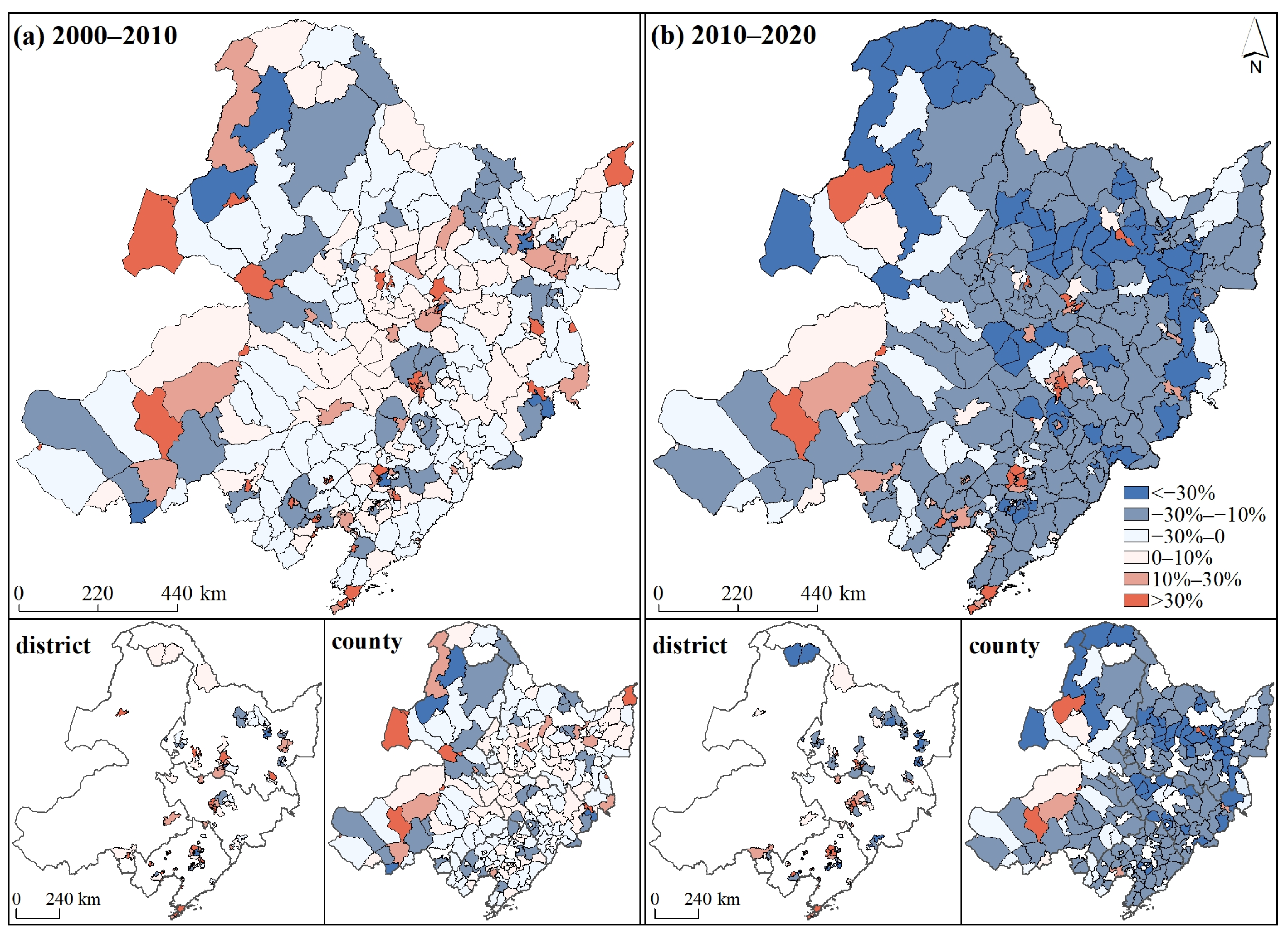
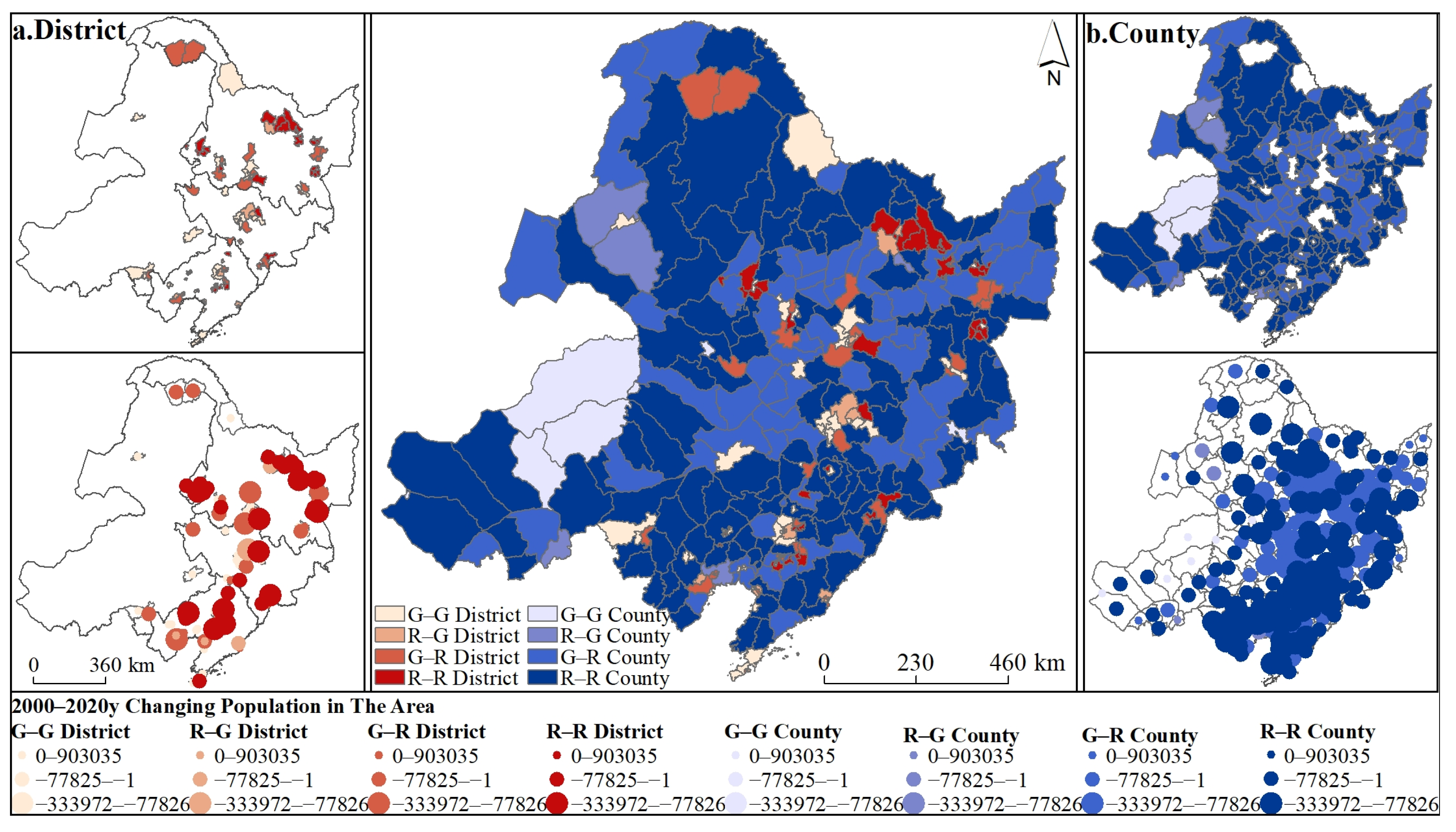

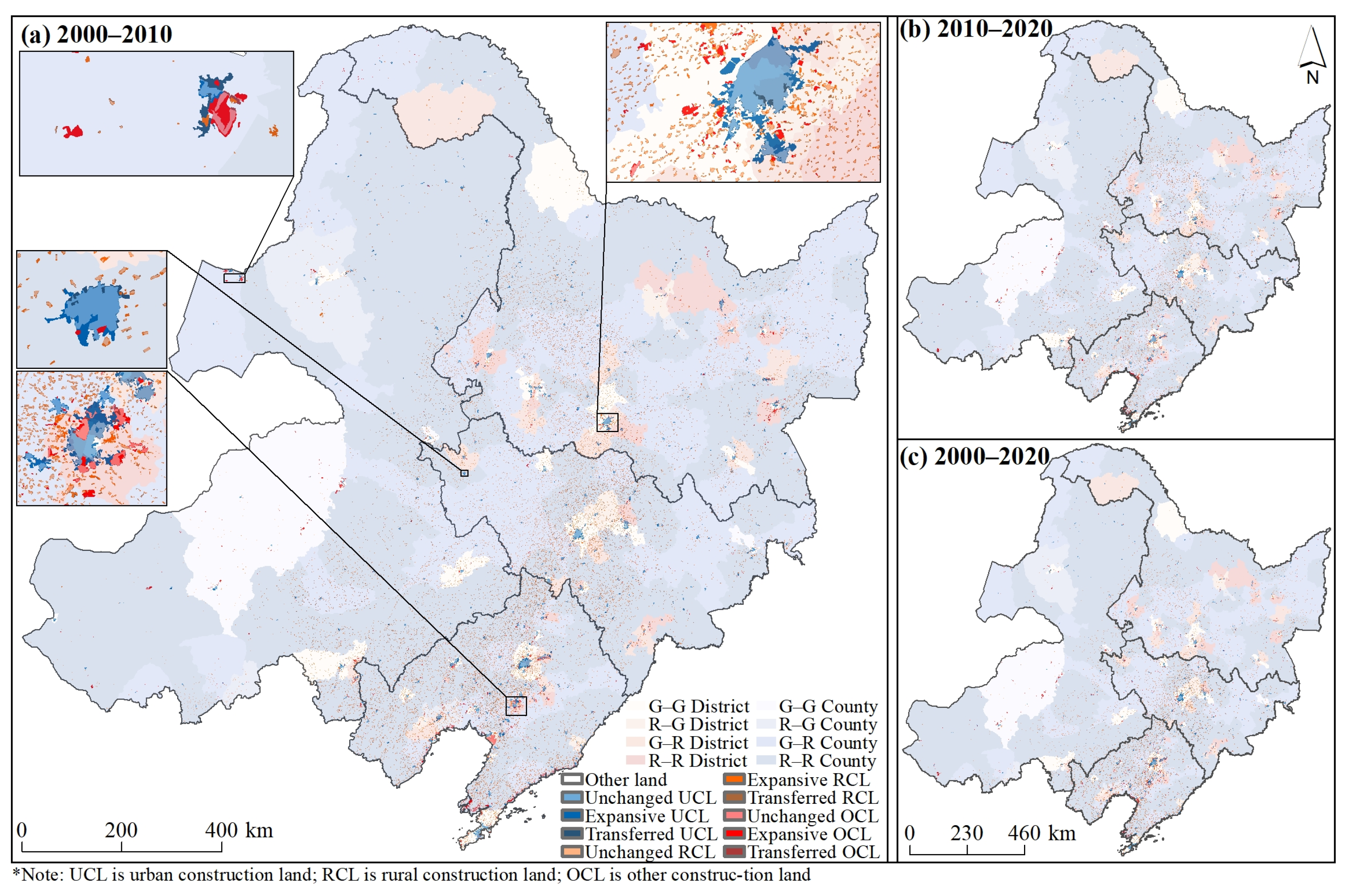
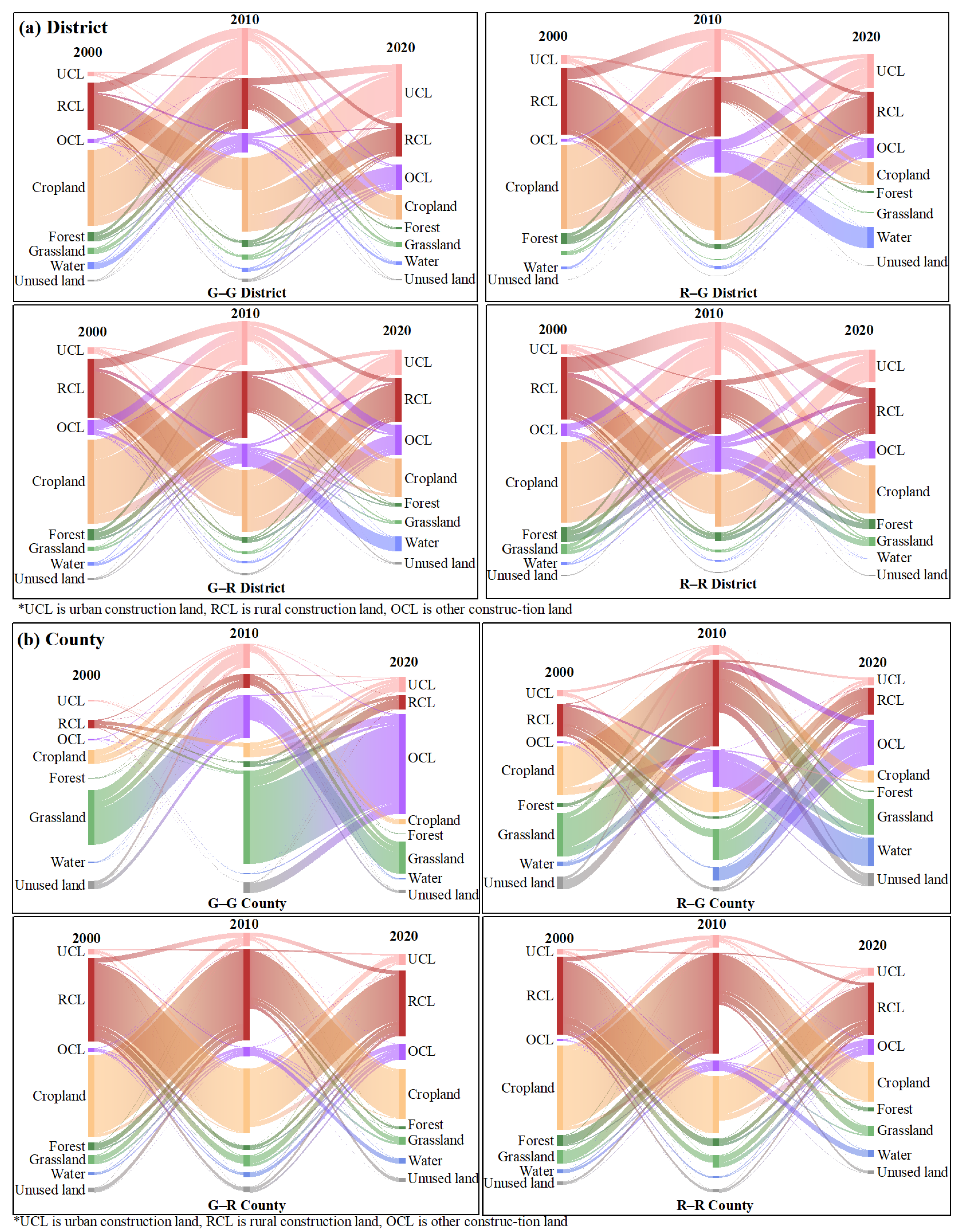

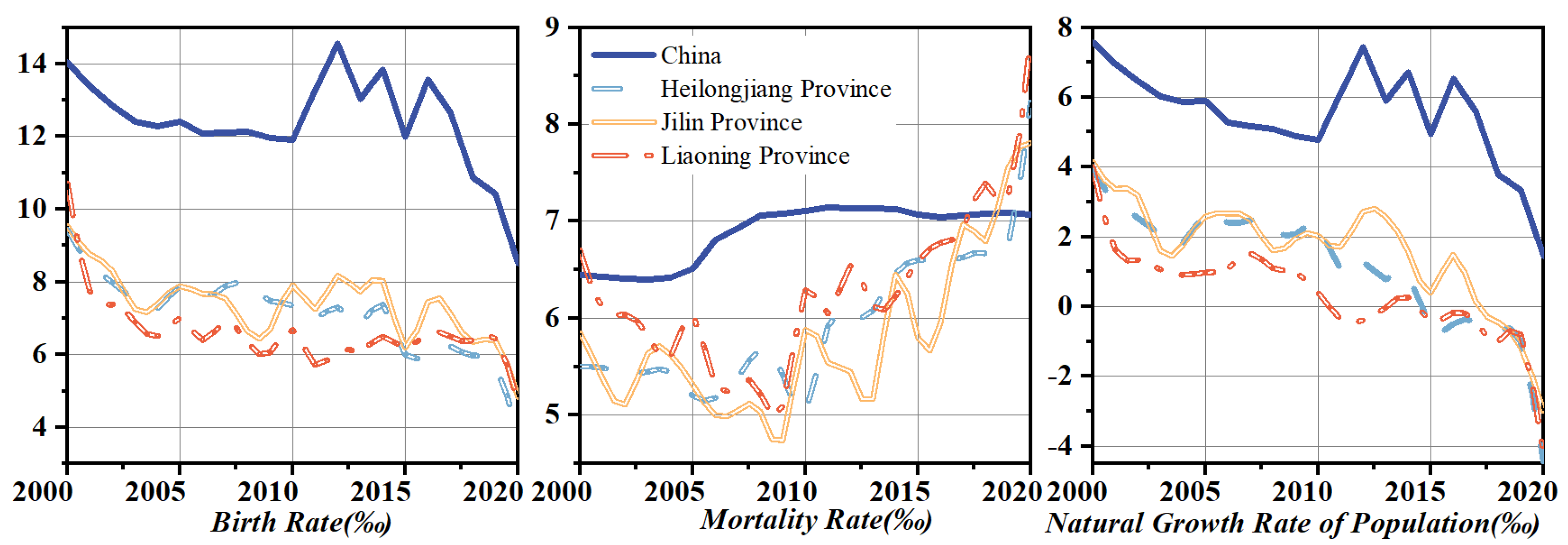
| Type | District | County | ||||||||||
|---|---|---|---|---|---|---|---|---|---|---|---|---|
| Period | 2000–2010 | 2010–2020 | 2000–2010 | 2010–2020 | ||||||||
| OCL | NCL | G | OCL | NCL | G | OCL | NCL | G | OCL | NCL | G | |
| G–G | 2709.73 | 1399.41 | 51.64% | 3501.93 | 1285.25 | 36.70% | 286.03 | 281.46 | 98.40% | 495.66 | 444.17 | 89.61% |
| R–G | 693.76 | 320.57 | 46.21% | 878.16 | 230.43 | 26.24% | 304.24 | 225.56 | 74.14% | 520 | 141.78 | 27.27% |
| G–R | 1943.4 | 709.71 | 36.52% | 2129.78 | 507.25 | 23.82% | 8306.69 | 3302.52 | 39.76% | 8620.75 | 2656.77 | 30.82% |
| R–R | 1101.36 | 543.3 | 49.33% | 1335.38 | 331.97 | 24.86% | 13,064.65 | 6999.31 | 53.57% | 14,996.48 | 4229.55 | 28.20% |
| Total | 6448.26 | 2972.99 | 46.11% | 7845.25 | 2354.9 | 30.02% | 21,961.61 | 10,808.84 | 49.22% | 24,632.89 | 7472.26 | 30.33% |
| Research Period | Sum | Filled Expansion | Sprawling Expansion | Enclave Expansion | ||||
|---|---|---|---|---|---|---|---|---|
| Expansion Area (km2) | Number of Patches | Expansion Area (km2) | Number of Patches | Expansion Area (km2) | Number of Patches | Expansion Area (km2) | Number of Patches | |
| 2000–2010 | 14,969.79 | 420,340 | 5.91% | 51.16% | 55.20% | 38.88% | 38.89% | 9.97% |
| 2010–2020 | 10,902.62 | 778,488 | 13.04% | 73.20% | 58.82% | 25.54% | 28.14% | 1.24% |
| Research Unit Type | Sum | Filled Expansion | Sprawling Expansion | Enclave Expansion | |||||
|---|---|---|---|---|---|---|---|---|---|
| Expansion Area (km2) | Number of Patches | Expansion Area (km2) | Number of Patches | Expansion Area (km2) | Number of Patches | Expansion Area (km2) | Number of Patches | ||
| District | G–G | 2240.04 | 35,239 | 5.59% | 67.04% | 66.34% | 26.72% | 28.07% | 6.24% |
| R–G | 531.70 | 7571 | 5.97% | 44.23% | 53.66% | 44.97% | 40.37% | 10.79% | |
| G–R | 793.45 | 28,325 | 7.38% | 73.57% | 56.47% | 21.44% | 36.15% | 4.99% | |
| R–R | 561.87 | 14,809 | 5.39% | 77.26% | 59.46% | 16.94% | 35.15% | 5.79% | |
| County | G–G | 569.21 | 6801 | 1.92% | 76.28% | 20.15% | 18.14% | 77.92% | 5.57% |
| R–G | 212.25 | 6181 | 5.18% | 61.43% | 37.28% | 30.27% | 57.54% | 7.30% | |
| G–R | 2692.66 | 193,872 | 9.19% | 76.85% | 49.99% | 19.27% | 40.82% | 3.88% | |
| R–R | 6248.48 | 320,812 | 7.60% | 67.36% | 47.50% | 26.19% | 44.91% | 6.46% | |
| Index | County | G–G County | R–G County | G–R County | R–R County | ||||||||||
|---|---|---|---|---|---|---|---|---|---|---|---|---|---|---|---|
| P | L | G | P | L | G | P | L | G | P | L | G | P | L | G | |
| P | 1 | 1 | 1 | 1 | 1 | ||||||||||
| L | 0.338 ** | 1 | 0.062 | 1 | 0.990 * | 1 | 0.549 ** | 1 | 0.190 * | 1 | |||||
| G | −0.087 | 0.68 | 1 | 0.965 ** | 0.209 | 1 | −0.759 | −0.697 | 1 | −0.276 * | −0.170 | 1 | −0.199 * | 0.212 * | 1 |
Publisher’s Note: MDPI stays neutral with regard to jurisdictional claims in published maps and institutional affiliations. |
© 2022 by the authors. Licensee MDPI, Basel, Switzerland. This article is an open access article distributed under the terms and conditions of the Creative Commons Attribution (CC BY) license (https://creativecommons.org/licenses/by/4.0/).
Share and Cite
Li, W.; Li, H.; Wang, S.; Feng, Z. Spatiotemporal Evolution of County-Level Land Use Structure in the Context of Urban Shrinkage: Evidence from Northeast China. Land 2022, 11, 1709. https://doi.org/10.3390/land11101709
Li W, Li H, Wang S, Feng Z. Spatiotemporal Evolution of County-Level Land Use Structure in the Context of Urban Shrinkage: Evidence from Northeast China. Land. 2022; 11(10):1709. https://doi.org/10.3390/land11101709
Chicago/Turabian StyleLi, Wancong, Hong Li, Shijun Wang, and Zhiqiang Feng. 2022. "Spatiotemporal Evolution of County-Level Land Use Structure in the Context of Urban Shrinkage: Evidence from Northeast China" Land 11, no. 10: 1709. https://doi.org/10.3390/land11101709
APA StyleLi, W., Li, H., Wang, S., & Feng, Z. (2022). Spatiotemporal Evolution of County-Level Land Use Structure in the Context of Urban Shrinkage: Evidence from Northeast China. Land, 11(10), 1709. https://doi.org/10.3390/land11101709




